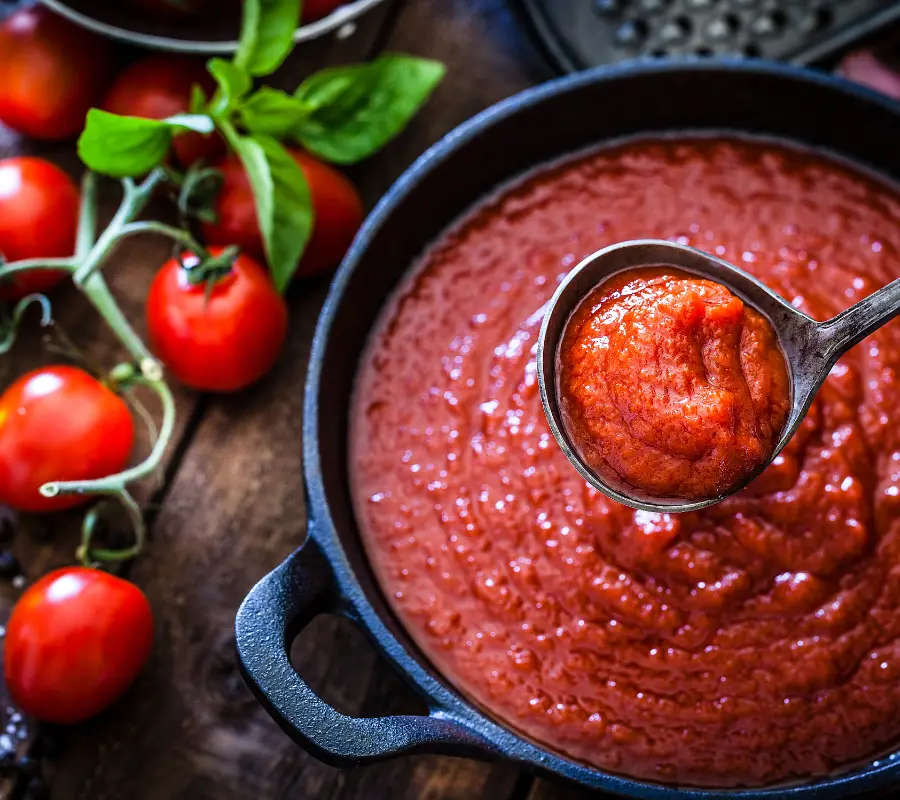What Are Sieved Tomatoes? With How To Guide
Sieved tomatoes, a popular ingredient in the culinary world, hold a special place in the realm of tomato-based products. Derived from ripe and juicy tomatoes, sieved tomatoes offer a unique texture and rich flavour that sets them apart from other tomato products like sauces or crushed tomatoes.
Whether you’re a seasoned chef or an aspiring home cook, understanding what sieved tomatoes are and how they can elevate your dishes is key to expanding your culinary repertoire.
In this article, we will delve into the world of sieved tomatoes, exploring their characteristics, culinary uses, and the process of making them. Join us as we uncover the secrets behind this versatile ingredient and unlock a world of delectable possibilities in your kitchen.

Explanation of what sieved tomatoes are
Sieved tomatoes, also known as passata or tomato purée, are a tomato-based product made by removing the seeds, skins, and any unwanted solids from ripe tomatoes through a process called sieving. The tomatoes are typically cooked briefly to soften them before being passed through a fine-mesh sieve or a food mill.
This process results in a smooth, velvety texture and a vibrant red colour. Unlike tomato sauce or crushed tomatoes, sieved tomatoes have a thicker consistency and contain no added ingredients or seasonings, making them a versatile base for a variety of culinary creations.
They provide a concentrated tomato flavor that enhances sauces, soups, stews, and countless other dishes, making them a staple ingredient in kitchens around the world.
Importance and Common Uses in Cooking:
- Flavorful Base for Sauces: The puree serves as an excellent base for various pasta sauces, such as marinara, Bolognese, or arrabbiata. Their concentrated flavour adds depth and richness to the sauce, while the smooth texture ensures a velvety consistency.
- Enhancing Soups and Stews: Adding sieved tomatoes to soups and stews infuses them with a vibrant tomato essence. Whether it’s a hearty vegetable soup, chilli, or a comforting minestrone, sieved tomatoes contribute a robust flavour and help create a harmonious base for other ingredients.
- Pizza Sauce: Sieved tomatoes are a go-to choice for making homemade pizza sauce. Their smooth texture spreads evenly over the dough while their natural sweetness balances out the savoury toppings. Sieved tomatoes offer a fresh and authentic taste that elevates homemade pizza to a whole new level.
- Versatile Ingredient: They can be used as a versatile ingredient in various recipes. They can be incorporated into meatball mixtures, casseroles, lasagnas, and even as a flavour enhancer in salad dressings or dips.
- Tomato-based Condiments: It can be seasoned with herbs, spices, and garlic to create flavorful condiments like tomato ketchup, salsa, or bruschetta topping. Their smooth texture ensures a consistent and easily spreadable product.
- Customizable Seasoning: One of the advantages of using sieved tomatoes is that you have complete control over the seasoning and flavours you add. You can adjust the salt, pepper, herbs, and spices according to your taste preferences, allowing for personalized creations.
- Time-saving Convenience: While sieving tomatoes at home requires some effort, using commercially prepared ones saves time and effort in the kitchen. They are readily available in stores and can be conveniently used whenever a recipe calls for a tomato base.

The texture vs other tomato products
Sieved tomatoes possess a distinct texture that sets them apart from other tomato products. Here’s a closer look at their texture and a comparison with other common tomato products:
- Smooth and Velvety: Sieved tomatoes have a smooth and velvety texture due to the removal of seeds, skins, and any undesirable solids during the sieving process. This results in a uniform consistency, free from any lumps or chunks.
- Thicker Consistency: Sieved tomatoes have a thicker consistency than tomato sauces or crushed tomatoes. While they are not as thick as tomato paste, their texture is denser than tomato sauce, allowing for a more substantial mouthfeel and better adherence to dishes.
- Less Watery: Sieved tomatoes have less water content than other tomato products. This characteristic contributes to a more concentrated tomato flavour and prevents excessive liquid from diluting the dish during cooking.
- Homogeneous Texture: Sieved tomatoes offer a homogeneous texture throughout, ensuring consistent flavour distribution in recipes. This even texture makes them ideal for sauces, soups, and other dishes where a smooth, uniform blend is desired.
- No Fibrous Components: As the seeds and skins are removed during the sieving process, sieved tomatoes do not contain any fibrous components. This makes them particularly suitable for recipes with a desired smooth texture, eliminating any potential chewiness or graininess.
- Versatility in Application: The texture of sieved tomatoes allows for versatility in their application. They can be used as a base for thickening sauces, providing a smooth and rich consistency, or as a topping for pizzas, where their texture spreads evenly and seamlessly over the dough.
It’s important to note that the texture of sieved tomatoes can vary slightly depending on the specific brand or preparation method.
However, in general, sieved tomatoes offer a smooth, velvety, and thicker texture compared to other tomato products, making them an excellent choice for achieving a balanced and refined texture in various culinary creations.

How to make sieved tomatoes step-by-step
The process of making sieved tomatoes involves transforming fresh ripe tomatoes into smooth, seedless, and skinless tomato puree. Here is a step-by-step guide to making sieved tomatoes:
It’s worth noting that commercially prepared sieved tomatoes are readily available in stores, which can save time and effort in the kitchen. However, making sieved tomatoes from scratch provides the opportunity to control the quality, freshness, and flavour of the final product.
How To Sieve Tomatoes For Tomato Puree
Materials
- Ripe Vibrant Tomatoes
Instructions
Selecting Ripe Tomatoes
- Choose ripe tomatoes with vibrant colour and a slightly soft texture. Varieties such as Roma, San Marzano, or plum tomatoes are commonly used for sieving due to their meaty texture and low water content.
Washing and Preparing the Tomatoes
- Rinse the tomatoes under cold water to remove any dirt or impurities. Remove the stems and any blemished or damaged parts of the tomatoes.
Blanching the Tomatoes
- Fill a large pot with water and bring it to a rolling boil. Carefully place the tomatoes in the boiling water for about 30-60 seconds. This blanching process helps loosen the skin, making it easier to remove later.
Shocking the Tomatoes
- Using a slotted spoon or tongs, transfer the blanched tomatoes into a bowl filled with ice water. This "shocking" process helps cool the tomatoes rapidly and stops the cooking process. Allow them to sit in the ice water for a couple of minutes.
Peeling the Tomatoes
- Once the tomatoes have cooled, remove them from the ice water. The blanched tomatoes will have loosened skins. Starting from the bottom or where the skin has already split, gently peel off the skin using your fingers or a knife.
Removing Seeds and Unwanted Solids
- Cut the peeled tomatoes in half and scoop out the seeds and jelly-like pulp using a spoon. Discard the seeds and any tough or undesirable parts of the tomato. This step is crucial in achieving a smooth, seedless tomato puree.
Sieving the Tomatoes
- Place a fine-mesh sieve or a food mill over a large bowl or container. Working in batches, press the tomato halves through the sieve or food mill, using the back of a spoon or a pestle. This will separate the tomato flesh from any remaining solids, resulting in a smooth tomato puree. Repeat the process until all the tomatoes are sieved.
Storing Sieved Tomatoes
- Once sieved, the tomatoes are now transformed into sieved tomatoes or tomato puree. Transfer the puree to airtight containers or sterilised glass jars, leaving a little headspace to allow for expansion during freezing or refrigeration. Store in the refrigerator for immediate use or freeze for longer-term storage.
FAQ’s
Sieved tomatoes have a relatively long shelf life. When stored properly in an airtight container or jar, they can last for up to one year in the freezer and about one week in the refrigerator after opening.
Yes, sieved tomatoes can be used as a substitute for tomato sauce. They provide a similar flavor base and can be seasoned according to your preferences. However, keep in mind that the texture and consistency may vary slightly, so adjustments might be needed in certain recipes.
Yes, sieved tomatoes are naturally gluten-free. They contain no gluten or gluten-containing ingredients. However, always check the labels of commercially prepared sieved tomatoes to ensure they haven’t been cross-contaminated with gluten during processing.
After opening, transfer any unused sieved tomatoes to an airtight container or jar and store them in the refrigerator. Make sure to use them within a week to maintain their quality. If you have a larger quantity, you can portion them and freeze them for longer storage.
Yes, you can make sieved tomatoes at home without a food mill. If you don’t have a food mill, you can use a fine-mesh sieve and press the tomatoes through it using the back of a spoon or a pestle. This method may require a bit more effort, but it can achieve similar results.
Sieved tomatoes can be preserved through canning methods. Properly sterilize canning jars, fill them with hot sieved tomatoes, leave appropriate headspace, seal them tightly.
